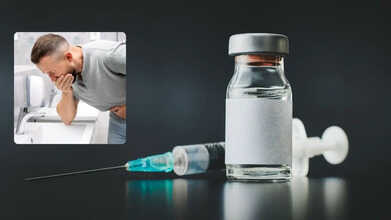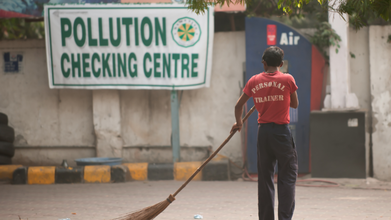- Health Conditions A-Z
- Health & Wellness
- Nutrition
- Fitness
- Health News
- Ayurveda
- Videos
- Medicine A-Z
- Parenting
Is Your Sore Throat Viral, Bacterial Or Allergic? Find Out Here

Image Credit: Canva
One of the commonest causes of illness, a sore throat often clears up on its own, but knowing what's causing it is important to treat it properly. Viral, bacterial, or caused by allergic elements - these kinds of sore throats have different characteristics that need different responses.
Sore throats have several origins, including infection and environmental factors. Some common causes include:
Viral infections: Viruses cause 90% of sore throat cases. Sore throats may result due to flu or common cold as well as those from chickenpox and measles that can all cause irritation.
Bacterial Infections: Streptococcus bacteria, the most common cause of strep throat, is the most common bacterial source. Strep throat is contagious and can lead to complications if untreated.
Allergies: Pollen, pet dander, and mold can trigger throat irritation, often accompanied by postnasal drip, sneezing, and watery eyes.
Environmental Factors: Dry air, pollution, and smoke can dry out or irritate the throat, creating a scratchy sensation.
Other Causes: GERD, vocal strain, even tumors may be responsible for chronic sore throats.
How to Distinguish Between Viral, Bacterial, and Allergic Sore Throats
Determining your cause of sore throat requires analysis of symptoms that accompany it, how long the sore throat lasts, and how bad the sore throat is.
Viral Sore Throats
The viruses that cause a sore throat are usually similar to a cold in their symptoms and tend to be milder than bacterial infections.
Symptoms of Viral Sore Throat
- Red, swollen throat without white patches
- Persistent cough
- Runny nose and nasal congestion
- Fever, usually mild
Duration: Viral infections last for 7–10 days without antibiotics.
Treatment: Home remedies, such as warm fluids, saltwater gargling, and over-the-counter pain relievers can help alleviate it.
Also Read: Flu Season Grips 40 States In US, CDC Reports Alarming Numbers
Bacterial Sore Throats
Bacterial sore throats, mainly strep throat, are more severe and require prompt medical attention to prevent complications.
Symptoms of Bacterial Sore Throat
- Red and swollen tonsils with white patches or streaks of pus
- High fever
- Absence of a cough
- Nausea, vomiting, or stomach pain (especially in children)
- Small red spots on the roof of the mouth
Diagnosis: Rapid strep tests or throat cultures confirm the presence of bacteria.
Treatment: Antibiotics are necessary to eliminate the infection. Without treatment, complications like rheumatic fever or abscesses can develop.
Sore Throats Caused by Allergies
Throat irritation is caused by postnasal drip. Allergies create a buildup and drip of mucus down the back of the throat.
Allergic Sore Throat Symptoms
- Irritation of the throat and ears
- Runny eyes, sneezing, and nasal congestion
- These symptoms are usually relieved by antihistamines or removal from the source of the allergen
Duration: Allergic sore throats are sustained for as long as the allergens are exposed.
When to Seek Medical Care?
A sore throat should be taken to a doctor if:
- The condition lasts more than a week.
- There is shortness of breath or swallowing becomes painful.
- Swelling is too pronounced or the pain in the throat is extreme.
- High fever, rash, or joint pain occur along with the sore throat.
- A child shows signs of dehydration or refuses fluids due to throat pain.
Early diagnosis can prevent complications and speed recovery.
Effective Treatment for Sore Throats
Home Remedies for Viral and Allergy-Related Sore Throats
Viral infections and allergies often respond well to non-invasive treatments:
- Drink warm teas, broths, or water to soothe the throat.
- Gargling with warm, salty water can reduce inflammation.
- These help soothe an irritated throat and can alleviate coughing.
Let your body rest sufficiently. Humidifying dry air will help keep the throat moist, especially when winter is on its way.
Why Not All Sore Throats Require Antibiotics?
Bacterial infections require antibiotics such as penicillin or amoxicillin. Finish the treatment completely to avoid reoccurrence or resistance.
How to Keep Sore Throats at Bay When Winter Is Near
Prevention is better than cure, and simple lifestyle changes can reduce your risk:
- Wash your hands frequently to avoid infections.
- Avoid close contact with sick individuals.
- Use air purifiers to minimize exposure to irritants.
- Stay hydrated and maintain a balanced diet to boost immunity.
Understanding the cause of your sore throat—whether viral, bacterial, or allergic—is key to effective treatment and recovery. While many sore throats resolve on their own, seeking timely medical advice for persistent or severe symptoms can prevent complications. Prioritize self-care, and don’t hesitate to consult a doctor when needed. Remember, your throat’s health is a vital part of your overall well-being.
Adenovirus: Highly Contagious Mystery Illness Spreading Fast, Watch Out for These 12 Symptoms

Credits: Canva
The so-called “mystery virus” behind lingering sore throats, blocked noses filled with mucus, and days of exhaustion is actually well known to doctors. According to Eric Sachinwalla, medical director of infection prevention and control at Jefferson Health, the culprit is adenovirus.
What makes this virus particularly difficult to control is how tough it is. Adenovirus can survive soap and water, withstand many everyday disinfectants, and linger on contaminated surfaces for long stretches of time. Below is what experts know so far about this fast-spreading infection.
What Is Adenovirus?
Adenovirus refers to a group of common viruses that usually trigger cold- or flu-like illness. It spreads easily because it is far more resilient than many other viruses. Ordinary soap, water, and standard disinfectants do not reliably destroy it, allowing it to persist in the environment. As a result, infections often cluster in places where people spend time close together, such as daycares and military barracks. The virus spreads through the respiratory tract, can be shed in stool, and can survive for some time on contaminated surfaces, according to the CDC.
Adenovirus: What Are The Symptoms Of Adenovirus?
“Adenovirus is a typical virus that causes common cold or flu-like symptoms,” says Dr Deborah Lee at Dr Fox Online Pharmacy. That does not mean adenovirus is the same as a cold. Instead, adenovirus is one of many germs that can cause cold-like illness. A simple way to think about it is that a “cold” describes the symptoms, while adenovirus is one specific virus that can lead to them.
Symptoms can vary depending on the subtype involved. While there are more than 100 known subtypes, only 49 infect humans. Dr Lee notes that people may experience any of the following:
- Fever
- Runny nose
- Sore throat
- Swollen cervical lymph nodes in the neck
- Cough
- Shortness of breath
- Conjunctivitis
- Ear pain
- Diarrhoea
- Vomiting
- Stomach pain
- Urinary tract infection
Adenovirus? Is It Contagious?
“Adenovirus infection is highly contagious,” Dr Lee explains. “It spreads by breathing in infected droplets, by touching the virus and then rubbing the eyes, or through the faecal-oral route, often due to poor hand hygiene after using the toilet.”
She adds that the virus spreads quickly in crowded settings where people are in close contact. To eliminate adenovirus from surfaces, Dr Lee recommends stronger cleaning agents such as bleach-based solutions or hydrogen peroxide. “The virus is resistant to soap and many commonly used cleaners,” she says.
To reduce the risk of catching adenovirus or other respiratory infections currently circulating, Dr Lee advises staying away from people who are unwell. She also suggests the following precautions:
- Avoid touching your face and nose
- Use a clean tissue to blow your nose and dispose of it immediately
- Wash your hands often with soap and warm water, then dry them thoroughly, especially after using the toilet or changing nappies
- Clean children’s toys regularly
- Disinfect worktops, changing areas, toilets, and bathrooms
- Avoid sharing cups, plates, food, or towels
- Wear a mask if you need to go out while unwell
- Keep windows open and ensure rooms and workspaces are well ventilated.
Norovirus 2025: Is There A Vaccine For The Stomach Bug Spreading This Year?

Credits: Canva
Dozens of norovirus outbreaks have been recorded nationwide over the past few weeks, and as people deal with intense vomiting, diarrhea, and other uncomfortable or even risky symptoms, a common question keeps coming up: why is there still no vaccine for such a widespread infection.
The Centers for Disease Control and Prevention (CDC) says norovirus cases are increasing toward the end of 2025, with higher activity reported in both the US and the UK. Health officials note that a new, highly infectious strain known as GII.17 is partly driving this rise. Because many people have little or no immunity to it, outbreaks are being seen more often in schools and shared public spaces. While overall case numbers remain within typical seasonal ranges, recent weeks have shown a clear upward trend.
What Is Norovirus?
Norovirus is an extremely contagious virus that leads to gastroenteritis. It commonly causes symptoms such as vomiting, diarrhea, nausea, and stomach cramps, and may also bring fever and body aches. It is often referred to as the ‘stomach flu,’ though it has no connection to influenza.
The virus spreads quickly through contaminated food or water, shared surfaces, or direct contact with an infected person’s vomit or stool. Crowded settings like cruise ships are especially vulnerable. Most people recover within one to three days with rest and enough fluids, according to the CDC.
Norovirus Symptoms 2025
Norovirus usually comes on suddenly, causing vomiting, watery diarrhea, nausea, and abdominal pain. Fever, headaches, and body aches are also common. Symptoms typically appear 12 to 48 hours after exposure and last for one to three days. Because it spreads so easily, infections can move fast through families and communities.
While most cases improve on their own, dehydration is a concern, so warning signs such as intense thirst or reduced urination should not be ignored, as noted by the Cleveland Clinic.
Do We Have A Norovirus Vaccine?
At present, there is no widely available vaccine for norovirus. That said, research has made meaningful strides. Experimental oral vaccines have shown encouraging results in clinical studies, suggesting they may offer protection against multiple fast-changing strains and help reduce how much virus an infected person sheds. Scientists are hopeful that an effective, broadly protective vaccine may become available in the coming years, according to the National Institutes of Health.
Why Don’t We Have a Norovirus Vaccine Yet?
Developing a vaccine for norovirus has proven especially difficult, largely because of how quickly the virus changes. “It really is evolving extremely rapidly, and that’s a big problem,” Patricia Foster, PhD, professor emerita of biology at Indiana University Bloomington, told Health.
Norovirus also exists in dozens of subtypes, with several dominant strains circulating at any given time. This is why people can catch norovirus more than once in their lives. Even if immunity develops against one strain, either after infection or through vaccination, another strain can still cause illness. Centers for Disease Control and Prevention. About norovirus.
Norovirus: Multiple Vaccines Are In The Works
Despite these obstacles, vaccine research is moving forward. Progress has accelerated in part because of newer technologies developed over the past decade. In 2016, Mary Estes, PhD, a researcher at Baylor College of Medicine, and her team found a way to grow norovirus outside the human body. This breakthrough made it possible to test vaccine approaches and treatments more effectively. This step was crucial because common lab animals like mice do not typically get sick from human norovirus.
Today, scientists are testing several experimental vaccines. One example is a 2023 vaccine developed at Washington University School of Medicine in St. Louis that combines protection against norovirus with an existing rotavirus vaccine. Several pharmaceutical companies are also developing candidates, many of which are now in clinical trials, said Amesh Adalja, MD, senior scholar at the Johns Hopkins Center for Health Security, in comments to *Health*.
HilleVax, a Boston-based company, has been testing a norovirus vaccine originally developed by Japan’s Takeda. However, that candidate did not succeed in a phase II trial in June 2024. Meanwhile, a tablet-style norovirus vaccine from San Francisco-based Vaxart has completed phase I testing. Among the most promising efforts is Moderna’s vaccine, which is currently being tested in human volunteers.
Preventing Norovirus, Even Without a Vaccine
Norovirus spreads so easily that stopping it once someone falls ill can be very challenging. This is linked to the virus’s structure. Norovirus is a nonenveloped virus, similar to polio and other stomach-related infections. Because of this, neither hand sanitizers nor soap and water actually destroy the virus, Foster explained. “Handwashing helps because you’re physically rinsing the virus away,” she said.
As a result, basic hygiene practices, especially thorough handwashing, remain some of the most effective ways to lower risk, said Ming Tan, PhD, an infectious disease researcher and associate professor of pediatrics at Cincinnati Children’s Hospital Medical Center, speaking to *Health*.
If norovirus does strike, treatment options are limited. Staying hydrated is essential to avoid complications from fluid loss. Some people may also use medicines to control nausea or diarrhea, either over the counter or by prescription, such as Zofran. If severe symptoms develop, including confusion, high fever, or intense abdominal pain, medical care should be sought right away.
Is Delhi's Toxic Air Making You Sad And Grumpy? Here's What The Study Says

Credits: iStock
Could air pollution be making you grumpy? We know of the harmful impact of air pollution on our health, including various organs and functioning of our body, but can Delhi's worsening AQI impact how we feel?
There has been emerging evidence that point towards the impact of toxic air on psychological wellbeing and brain health. Polluted air can worsen anxiety, depression, heighten stress, and impair cognitive functions. It has raised fresh concerns with regards to air pollution.
In fact, speaking to HT, Dr Astik Joshi, who is Child and Adolescent and Forensic Psychiatrist at Fortis Hospital, Shalimar Bagh, said that worsening air conditions could make us more irritable, lower mood, and lead to depressive symptoms. “Toxic haze from long-term exposure to polluted air, specifically smaller airborne particles found in fine particulate matter such as PM2.5, is known to not only penetrate the blood and cross the blood-brain barrier; but when they reach the brain, they activate inflammatory responses and create oxidative stress, thereby disrupting the normal functioning of the brain," he tells HT.
When polluted air reaches brain, it reduces the levels of oxygen and could even lead to brain inflammation. This can impact in learning and memory areas of brain, and could lead to 'brain fog'.
What Do The Studies Say On Air Pollution And Mood?
A study published in Nature Communication notes that after four hours of exposure to particulate matter, it was found that people's ability to perform routine tasks and interpret emotions were highly impacted.
Study's co-author, Dr Thomas Faherty said, "Study provides compelling evidence that even short-term exposure to particulate matter can have immediate negative effects on brain functions essential for daily activities.”
Among all the cognitive abilities examined, two showed the clearest impact: selective attention and emotion recognition. People exposed to particulate matter air pollution experienced declines in both, regardless of how the polluted air entered their bodies.
Read: British Man Compares Breathing In Delhi To Smoking 18 Cigarettes
Selective attention is central to decision-making and staying goal-focused, while emotion recognition helps us read social cues and respond appropriately to others. When these functions are affected, everyday tasks can suffer. The study illustrates this through something as routine as grocery shopping: reduced selective attention can make it harder to stick to a list, increasing the likelihood of impulse purchases.
The implications stretch far beyond errands. Even brief exposure during a commute or a short walk could temporarily dull cognitive performance. A drop in attention can affect productivity, while impaired emotion recognition may make collaboration, meetings, and everyday workplace interactions far more challenging.
However, contrary to what Dr Joshi said, the study noted that no decline in working memory was seen. This means that some brain functions were quite resilient and are able to avoid the inflammation caused by pollution. However, more research is required to come to this conclusion, as in the study, the PM exposure was controlled and done by a candle smoke.
A 2002 study titled Air Pollution and Brain Damage, noted that long term exposure to air pollution could lead to cognitive disorders including Alzheimer's disease, Parkinson’s disease and multiple sclerosis.
© 2024 Bennett, Coleman & Company Limited

